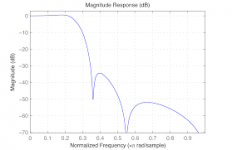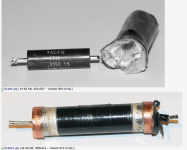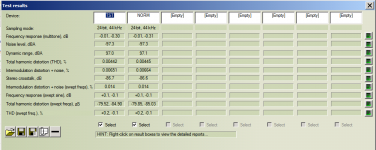The filters on the DAC output are not adequate. You can see from the 3 spectrum analyzer data shown at # 26278, when the filter comes in but atten is not great enough to remove enough HF noise/signal going to the amplifier/speaker.
Generally, all CFB amps can handle the HF OK with minimal increase in distortion, but VFB Amps cannot. At least in most cases for existing audio Power amps.


THx-RNMarsh
It is still in place... where do i get this Got Bass recording?
Not much listening... still sounds sharp and clearer than stock.
THx-RNMarsh
Generally, all CFB amps can handle the HF OK with minimal increase in distortion, but VFB Amps cannot. At least in most cases for existing audio Power amps.


THx-RNMarsh
RNM this album is 'got bass' bigtime, it's a pity your system is packed down. What did the extended background listening to the DAC-3 reveal ?.
Dan.
It is still in place... where do i get this Got Bass recording?
Not much listening... still sounds sharp and clearer than stock.
THx-RNMarsh
Sorry, I don't get what you are saying. If we assume for the moment (without checking) that you are correct to say that the resistance at 20kHz of 2m of 1mm wire is about the same as a Bybee, so what? What does that tell us? That a Bybee can replace 2m of wire? Surely 2m of wire is cheaper?RNMarsh said:skin effect freq (HF) is 90 out of phase with LF.
2 meters of 1 mm diam wire has Z due to skin-effect of about same as BYEBEE resistance at 20KHz.
There is no skin effect at LF, what is the above supposed to mean?
There is skin effect always above DC, but given the usual diameters of conductors used for music reproduction it' s impact is neglible at low frequencies.
I think, RNMarsh was using this fact, so only neglible skin effect at LF but already some not so neglible at higher frequencies and as it is an inductive effect the phase difference will be 90 degree for the skin effect. (the resulting phase will be different as there is a real part of resistance still left)
There is skin effect always above DC, but given the usual diameters of conductors used for music reproduction it' s impact is neglible at low frequencies.
I think, RNMarsh was using this fact, so only neglible skin effect at LF but already some not so neglible at higher frequencies and as it is an inductive effect the phase difference will be 90 degree for the skin effect. (the resulting phase will be different as there is a real part of resistance still left)

Hi Jacob, take a close look at the construction and you will see a Pacific 25mR resistor that goes inside and connected in parallel with a ceramic sleeve with 25R black conductive coating (1000:1 ratio), the outer cloth and heatshrink can be ignored for the purpose of this discussion. IIRC the Pacific resistor is made from Beryllium and the 25R coating on the ceramic sleeve consists of Rare Earth Oxides fused in a furnace over 36 hrs or so. The 25mR resistor is stated as having velocity of propagation of 0.6C and the 25R sleeve Vp of 0.92C. What happens when two currents out of time combine in ratio of 1000:1 ?. What is the field radiated by the resistor and how does the sleeve conductance interact with this field and what happens ?. Other interactions going on ?.
Dan.
Assuming those numbers are correct (provenance?) then what is the transit time for each, and what is the difference in time? Is that really where you want to hang your hat?The 25mR resistor is stated as having velocity of propagation of 0.6C and the 25R sleeve Vp of 0.92C. What happens when two currents out of time combine in ratio of 1000:1 ?.
What is the field radiated by the resistor and how does the sleeve conductance interact with this field and what happens ?. Other interactions going on ?.
Dan.
Based on measurements and reports of listening tests, nothing happens.
A very tiny phase shift, far too small to be of any significance to an audio circuit.Max Headroom said:What happens when two currents out of time combine in ratio of 1000:1 ?
The resistor will "radiate" almost nothing, assuming audio frequencies. (We have been told in the past that the Bybee does not work by blocking RF, so we can ignore RF). There will be a small local induction field, which the sleeve may attenuate a little. No consequence for audio.What is the field radiated by the resistor and how does the sleeve conductance interact with this field and what happens ?
By far the strongest interaction is between the wallet of the purchaser and the wallet of the seller. On the basis that where the wallet goes the heart follows, there is then an attempt to influence the hearts of others and recruit them to the cause.Other interactions going on ?
Ok good, I'm interested to know what you decide long term, plenty of time yet.It is still in place.
Not much listening... still sounds sharp and clearer than stock.
Dan.
"The resistor will "radiate" almost nothing, assuming audio frequencies. "
Not to take anything away from your excellent summary, don't forget it will radiate heat energy from I^2.R losses.
Not to take anything away from your excellent summary, don't forget it will radiate heat energy from I^2.R losses.
So is at high audio frequencies. That is unless you know of evidence on audible difference.There is skin effect always above DC, but given the usual diameters of conductors used for music reproduction it' s impact is neglible at low frequencies.
Spreading FUD again? 🙄I think, RNMarsh was using this fact, so only neglible skin effect at LF but already some not so neglible at higher frequencies and as it is an inductive effect the phase difference will be 90 degree for the skin effect. (the resulting phase will be different as there is a real part of resistance still left)
Just compared dan’s test tracks (subjectively)
Listened to track one....took notes....compared track two......noted differences.
Track 1. / Track2.
Compressed / Open
Smeared. / Focused, better separation
Shallow stage. /. Deeper stage
No dynamics. /. Dynamic
Unnatural effects. /. Natural effects
Lack of detail. /. Much more detail
Lack of leading edge transients /. Good leading edge, sharper detail with better decay
Don’t know if anyone cares but track two was a much better version to listen to.....how does this equate to the measurements Scott w took?
Listened to track one....took notes....compared track two......noted differences.
Track 1. / Track2.
Compressed / Open
Smeared. / Focused, better separation
Shallow stage. /. Deeper stage
No dynamics. /. Dynamic
Unnatural effects. /. Natural effects
Lack of detail. /. Much more detail
Lack of leading edge transients /. Good leading edge, sharper detail with better decay
Don’t know if anyone cares but track two was a much better version to listen to.....how does this equate to the measurements Scott w took?
Thanks Bob for going to the trouble of setting aside some time and writing things down, much appreciated.
So there you have it folks, according to MMB (sample data of one for now) the loopback recording sounds subjectively better than the original on a bunch of accepted audio criterion.
Convention says that more stages that audio goes through the worse it gets, but here a Youtube grab (of compressed streaming) after Pb/Rec process using a novel interconnect cable sounds better than the source and subjectively delivering more information, go figure !.
Bob's experience here accords with my experience here on a bunch of different audio systems and audio items.
I can redo this process starting with CD quality file if so wanted, however I/we need to establish agreed process to convert 16bit to 24bit and with attenuation of 50% to ensure no digital overs.
Dan.
So there you have it folks, according to MMB (sample data of one for now) the loopback recording sounds subjectively better than the original on a bunch of accepted audio criterion.
Convention says that more stages that audio goes through the worse it gets, but here a Youtube grab (of compressed streaming) after Pb/Rec process using a novel interconnect cable sounds better than the source and subjectively delivering more information, go figure !.
Bob's experience here accords with my experience here on a bunch of different audio systems and audio items.
I can redo this process starting with CD quality file if so wanted, however I/we need to establish agreed process to convert 16bit to 24bit and with attenuation of 50% to ensure no digital overs.
Dan.
how does this equate to the measurements Scott w took?
They were not measurements but simply actual views of the data.
Well I can tell you one thing track 1 sounded exactly like a YouTube track at my reference level. Track 2 sounded like a unadulterated 16/44.1 stream of normal/decent quality. If you can indeed make a you tube track sound that much better (the difference was quite noticeable). I’d say your on to something. The only thing I’d say there was maybe a slight ‘hash’ to track two but the benefits far outweigh it. Maybe what I call hash is this ‘grass’ that’s often mentioned?
Last edited:
It's quite common for people to subjectively prefer some distortion.The only thing I’d say there was maybe a slight ‘hash’ to track two but the benefits far outweigh it. Maybe what I call hash is this ‘grass’ that’s often mentioned?
It's quite common for people to subjectively prefer some distortion.
I could agree with that but would that extra distortion ‘transform’ the entire presentation?
I call that perceptive and reliable assessment......the Roland audio interface is somewhat noisy compared to more modern interfaces and does cause slight base noise, IMO however the base noise in the loopback recording is less objectionable and subjectively quieter than the source recording base noise.Well I can tell you one thing track 1 indeed sounded exactly like a YouTube track at my reference level. Track 2 sounded like a unadulterated 16/44.1 stream of normal/decent quality.
If you can indeed make a you tube track sound that much better (the difference was quite noticeable). I’d say you're on to something.
The only thing I’d say there was maybe a slight ‘hash’ to track two but the benefits far outweigh it. Maybe what I call hash is this ‘grass’ that’s often mentioned?

The interface is relatively blameless but could be quieter.
Perhaps a few others would like to take a closer listen now, or suggest another track.
Dan.
Last edited:
I don't see why not. Some swear by interconnects that inject some RF for instance.I could agree with that but would that extra distortion ‘transform’ the entire presentation?
I could agree with that but would that extra distortion ‘transform’ the entire presentation?
That is exactly why they have boxes like the one in the pic below. It adds distortion to spice up bland tracks. It's a BandAid effect though. If the original recording is good quality, added distortion only makes it sound worse.
Attachments
If the original recording is good quality, added distortion only makes it sound worse.
Can the Quantum be switched in or out?
- Status
- Not open for further replies.
- Home
- Member Areas
- The Lounge
- John Curl's Blowtorch preamplifier part III
